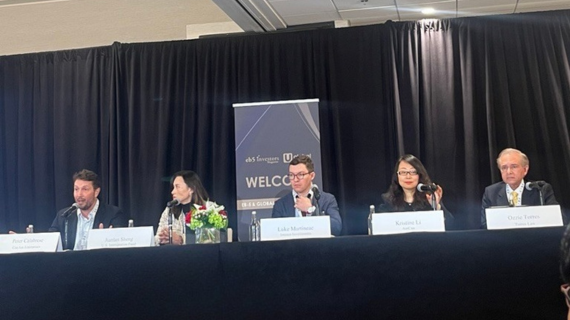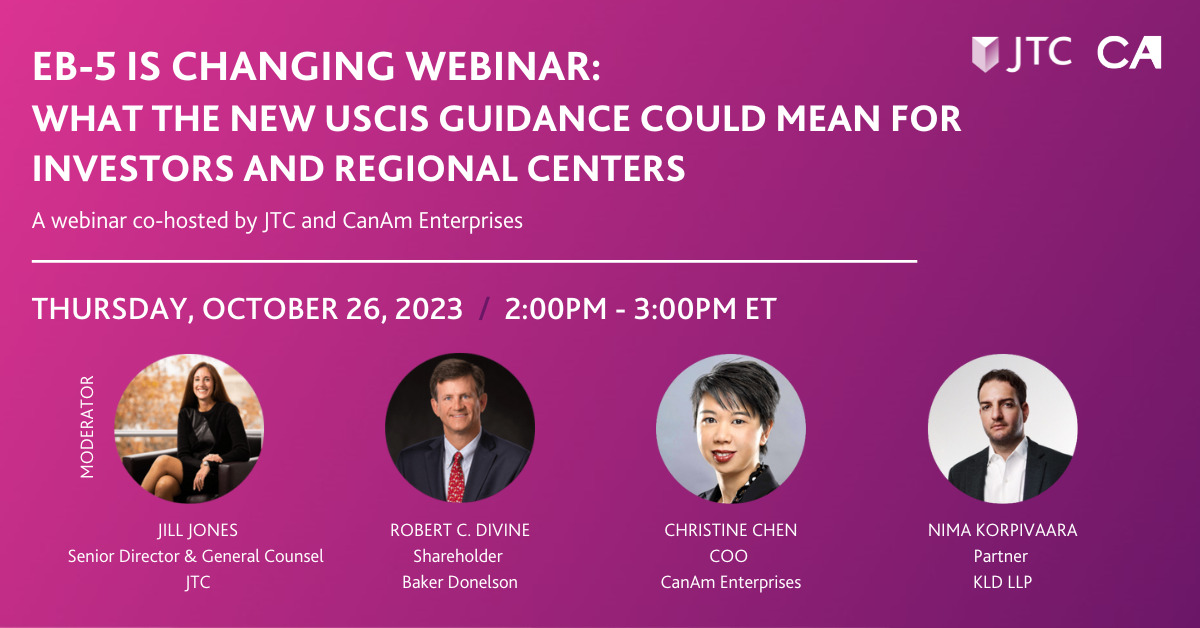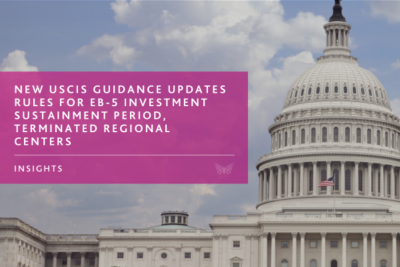
EB-5 industry leaders recently gathered in Newport Beach, California, for an insightful panel discussion on EB-5 investment strategies, hosted by Pete Calabrese, CEO of CanAm Investor Services. The discussion, titled “EB-5 Projects in Focus: Smart Strategies and Key Factors to Evaluate Investment Projects that Best Fit Your Migration Goals and Financial Means,” brought together a distinguished group of experts, including Kristine Li of AmCan, Luke Martineac of Immco Investments, Jianlan Sheng of U.S. Immigration Fund, and Osvaldo F. Torres of Torres Law. The conversation provided prospective EB-5 investors with valuable guidance on selecting the right investment project based on immigration, financial, and deal structuring considerations.
Immigration Factors for Investors in Project Selection
The panel opened with an examination of the key immigration factors that investors must consider when selecting an EB-5 project. Pete Calabrese moderated a lively discussion, in which Kristine Li and Luke Martineac provided perspectives on how overseas investors navigate their options, while Pete addressed the considerations for domestic clients.
A central point of discussion was choosing the right set-aside category for EB-5 investments. The panelists emphasized that selecting a category with available visas is crucial to avoiding excessive wait times. They noted that demand for EB-5 visas has surged, particularly in countries like China and India, where retrogression remains a challenge. Investors from these countries must carefully evaluate whether they are subject to visa backlogs and, if so, whether an available set-aside category—such as rural or infrastructure projects—could offer a faster path to obtaining a green card.
Another major factor discussed was the ability to concurrently file an adjustment of status (AOS). This option, available to investors already in the U.S. on valid nonimmigrant visas, allows them to apply for a green card while remaining in the country and securing work and travel authorization. Pete Calabrese highlighted how this pathway has become a strategic advantage for domestic investors, particularly those on temporary work visas who wish to transition to permanent residency without disruption.
Finally, the panel explored scenarios where priority processing could make a material difference. Some investors may benefit from selecting projects that align with priority processing criteria, allowing for a faster adjudication timeline and potentially securing green cards sooner.
Financial Factors in Project Selection
The discussion then shifted to the financial considerations that investors must weigh when selecting an EB-5 project. With the investment amount for a Targeted Employment Area (TEA) project set at $800,000, the panel explored options that offer flexibility in funding.
Osvaldo Torres provided an overview of deal structuring and how it affects investor liquidity and risk. Meanwhile, Kristine Li and Luke Martineac discussed various pathways investors take when funding their investments from an overseas perspective, with Pete Calabrese weighing in on strategies for domestic investors.
Among the key financing strategies discussed were:
- Extended timelines for funding: Some EB-5 projects allow for a phased funding approach, enabling investors to meet the investment threshold over a defined period.
- Filing with a partial investment: In some cases, investors can file their I-526E petition with a partial investment, completing the remainder of the investment after filing, subject to project-specific policies and USCIS regulations.
- Using the proceeds of a loan: Many investors fund their EB-5 investment through secured or unsecured loans. The panel discussed the risks and benefits of using borrowed funds, emphasizing the importance of ensuring the lawful source of funds and properly documenting the transaction.
These financial considerations are critical for investors seeking flexibility in structuring their investments while maintaining compliance with EB-5 regulations.
Deal Structuring Factors in Project Selection
The final portion of the discussion focused on deal structuring and capital stack considerations, which play a crucial role in determining the risk profile of an EB-5 project.
Osvaldo Torres elaborated on the importance of understanding where EB-5 investors stand in the capital stack and how this affects their level of risk. He explained that projects with EB-5 funds in a preferred position in the capital stack tend to provide investors with greater security, while those where EB-5 capital is subordinate to senior debt may pose additional risks.
Kristine Li and Luke Martineac discussed the length of the investment term, a key consideration for investors looking to plan their exit strategy. While EB-5 capital is typically committed for the duration of the investor’s conditional residency period (which generally extends five to seven years), variations in project structure and market conditions can affect the timing of capital return.
Pete Calabrese emphasized the importance of working with reputable regional centers and developers with a strong track record. Given the complexities involved in structuring EB-5 projects, investors should seek transparency on project financing, exit strategies, and risk mitigation measures before making their decision.
Conclusion: Smart Strategies for EB-5 Success
As the panel concluded, the speakers reiterated the importance of a holistic approach to EB-5 investment selection—one that balances immigration priorities, financial flexibility, and sound deal structuring. Investors must assess whether they are subject to retrogression, explore funding options that align with their financial situation, and understand the risk profile of the projects they consider.
With evolving regulations and increasing demand for EB-5 visas, making informed decisions has never been more critical. The insights shared in this discussion serve as a valuable guide for investors navigating the EB-5 process in 2025 and beyond.
For more information about CanAm Enterprises and its EB-5 investment opportunities, visit [CanAm’s website] or contact their team for a consultation.
Diver Deeper Into EB-5:




